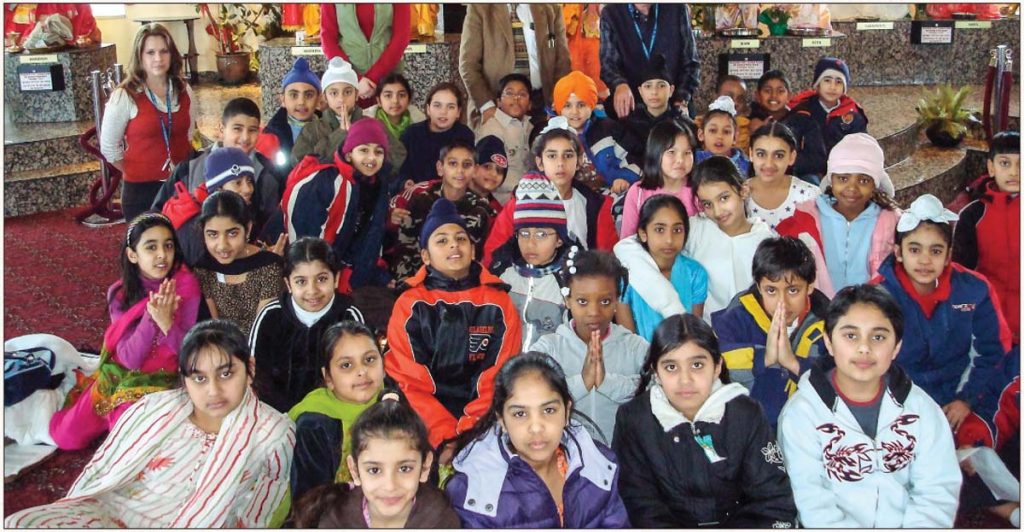Four stories from HINDUISM TODAY’S intern writing program bode well for the future of Hindu journalism

Our attempt to solicit more youth voices for Hinduism Today started with a largely unsuccessful appeal to overly-busy college-age Hindus but led to an enthusiastic response from middle and high school students, who demonstrate in these four insightful articles that they are quite up to the task
This Is How One American-Raised Hindu Prays
By Shaina Grover, 16
GROWING UP IN AMERICA IS OBVIOUSLY NOT THE SAME AS growing up in India, and being a Hindu raised in America and India are two very different experiences. Being raised in India will often mean that a child has a greater understanding of their religion, its practices and beliefs. Being raised as a Hindu in America can be a little confusing. While we follow some aspects of Hindu culture and aim to understand them, we also must follow American culture. Our identity is a mixture of both Hindu and American beliefs. And it’s not just the kids raised in America—their parents, who immigrated to the US, definitely don’t participate in the same traditions as they used to. I’m a Punjabi Hindu, so in my family we believe you shouldn’t do certain things on Tuesdays and Thursdays, such as the laundry. My grandparents, who lived their entire lives in India, follow this strictly and probably understand the reasoning behind it. Although my parents and I try to follow these to the best of our abilities, certain things in our lifestyle as a person living in the US often interfere. Essentially, even though we are Hindus, living in America has diminished how much we participate in certain Hindu traditions.
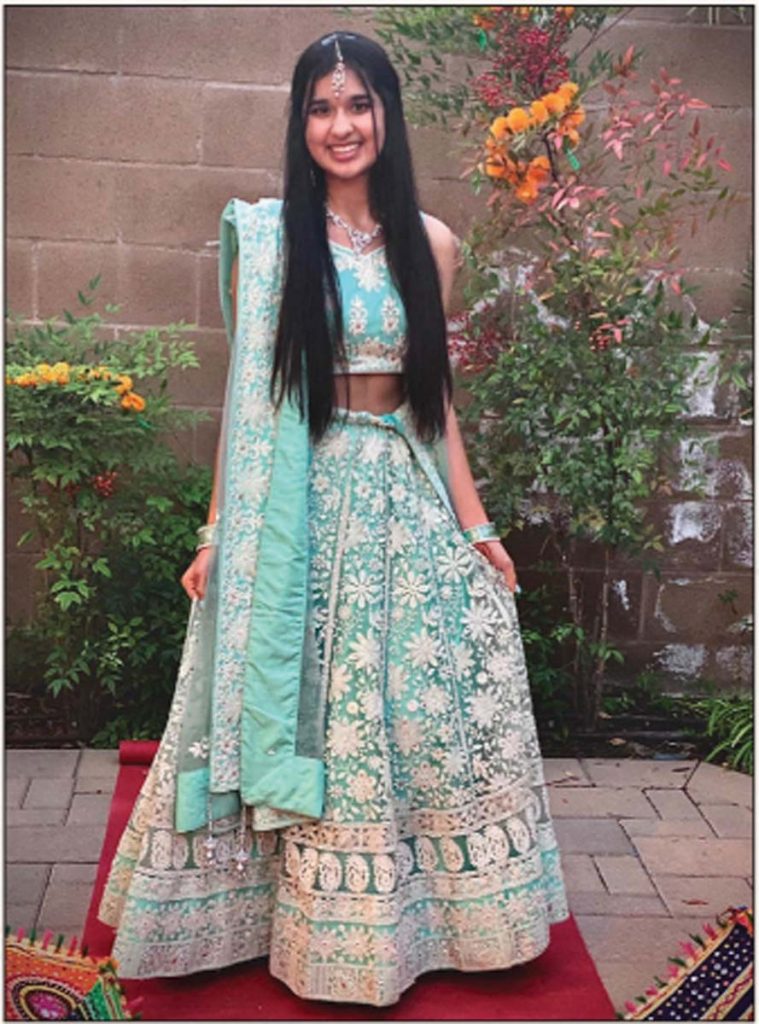
That’s not to say we don’t follow anything properly, or that we aren’t in touch with our culture and religion. Looking back on my life, I’ve probably been praying or participating in one puja or another since before I knew what that was. I’ve sat in front of the temple, with my eyes closed, palms touching, “praying,” before I even understood what belief was, what worshiping was, or what praying even meant.
As I grew older, I enrolled in Hindi classes and started lessons in Kathak, a North Indian classical dance style, which I still take. Both allowed me to learn more about our culture. In Kathak, the goal is to tell a story through dance and expressions. More often than not, these stories are about different Gods. Whether it’s a playful dance about Krishna and Radha Ji, or a story about Hanuman Ji saving a village, as I became older I came to understand the deeper meaning behind the dances.
By talking to and listening to my grandparents and parents, I learned about the different Gods, the mythology and why traditions are the way they are. For example, as a little kid, I didn’t know why we would light oil lamps or do fireworks on Diwali, but when I was old enough to understand, I read the Ramayana and learned the origin of the festival in His triumphant return to Ayodhya. I was able to take these stories, make connections and see how this applied to my life. Out of the several themes in the story, one of them being good versus evil, I learned to incorporate in my everyday life the belief that good always triumphs over evil.
My parents told me to pray and participate in pujas, so I did, and they taught me about their beliefs, but that does not mean I pray because I have to. Even though the habit of prayer was instilled in me by my parents from a young age, I continue to pray because I believe in the Gods and Their role in our lives.
An important distinction to keep in mind is the difference between believing and praying. Even though I believe that there is a higher power and that the Gods we worship and pray to can provide us guidance in our lives and They have the power to change our lives, this isn’t the same thing as praying. You may believe in the Gods, but do you take the time to sit down in your home shrine or go to the temple to communicate with these Gods?
For me, praying isn’t something I spend a big part of my day doing. When I remember, I will quickly stop by the temple, but oftentimes it’s not for more than a minute. However, on festivals such as Diwali, Navaratri, Janmashtami, and more, we sit down in our temple and pray as a family. This is time that is set apart for praying that day.
There are some youth who will pray every day for a certain amount of time, while others will only do it with their families, but it’s still not as much as the generations before them. In my family, my mom does puja in the morning and she even fasts once a week. My grandparents do that and more. Every Thursday, my grandparents attend a satsang gathering (by Zoom during the pandemic). They always light an oil lamp in the morning and pray before starting their day.
All in all, growing up in America is definitely a different lifestyle than growing up in India or immigrating to the US after college. The way you are brought up and the things you are taught are different. The reality we need to face is that as the world itself becomes more modernized and children more educated, they develop their own opinions and drift farther and farther away from our culture, regardless of where they live. However, even if your culture and religion are not a big part of who you are, that’s okay, as long as you don’t forget or ignore them. It is important to at least make an attempt to learn more about your culture and participate in its traditions. While it may not always make sense, the only way you can achieve something out of praying is by setting aside time and giving your prayers your undivided attention—something even I struggle with. By spending time with my grandparents, listening to their stories, reading books, etc., I have gained a deeper understanding of my Hindu background.
I Made Better the Way My Classmates Studied India
By Sanjeevani Dedge, 12
EVER SINCE I WAS LITTLE, I HAVE BEEN deeply involved in my culture and traditions and wanted others to learn about them as well. For example, I showed my entire first-grade class the sun salutations, with my parents’ help. We distributed posters so everyone could practice at home. My class enjoyed the experience so much that we practiced it several times again throughout the year. Growing up further, I came to understand that California social studies class for 6th and 7th grade had inaccurate and unfair content on Hinduism. I decided to do my best to change that.
During my 6th-grade year, I realized that the class was spending quite a while on other ancient civilizations, and I was nervous that there would not be enough time left for ancient India. My suspicions came true, and I was concerned that my teacher would not get enough time to cover India. I most certainly wanted my classmates to learn about ancient India’s achievements, traditions, economics and social structure as well!
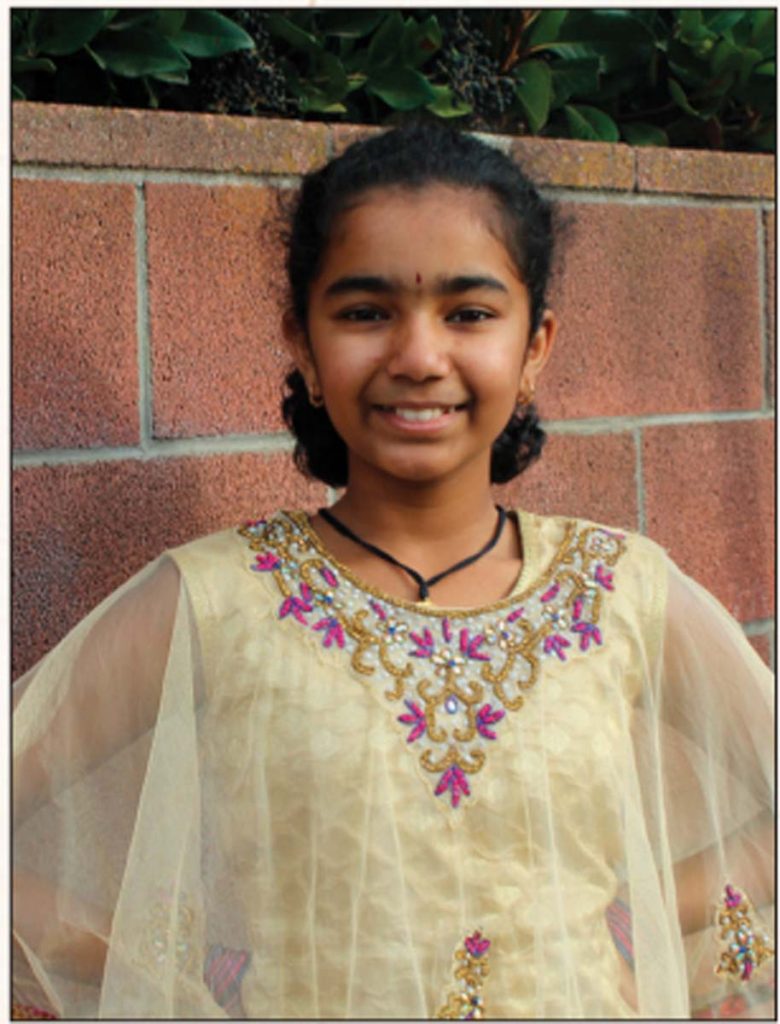
I discussed these problems with my school friends, the teacher and also my parents. They understood my concerns, and we brainstormed what we could do. Hearing how my friends in other schools had a similar learning experience—being able to study only the geography of ancient India—inspired me to suggest that my dad also talk about ancient India in class to add to what my teacher covers. He talked with my teacher and the vice-principal, and they were very cooperative and glad to have my dad teach in my class. Ahead of his session, my dad handed pamphlets of “History of Hindu India” to the class and shared the resources over Google drive as well. He presented two full sessions over two days, and my classmates and teachers enjoyed it. I was delighted because he not only briefly covered again the important geographic sites of ancient India, such as Mohenjo Daro and Harappa, he also covered the Hindu roots in ancient India, contributions of Hindu women, sages Valmiki and Vyasa, history of the Vedas and other important traditions.
That same year (2019), I introduced my classmates to Diwali. To me, Diwali symbolizes light over darkness, good over evil. At home, I celebrated by making a mud fort in our driveway (bit.ly/diwalifort), lighting oil lamps and distributing sweets to friends. Earlier, when I was in 5th grade, my mom did a presentation to my class and drew a rangoli design with rice flour on the floor in front of the classroom door. This year I wanted all my classmates to learn about it as well. So, a few of my Indian friends and I talked to my teacher about how we could explain Diwali, and we took her permission to share different Indian sweets with the class. Everybody loved learning about Diwali and tasting all the different sweets my friends and I had brought, and it was great to see everybody having such a great time!
I learned many things throughout this year-long experience. The most important things were being proactive regarding your values by voicing your concerns, reaching out to others and finding help.
Overall, it was great to witness my classmates learning so much about India. I loved seeing how my contributions changed their learning experience for the better. With this positive thought in mind, I look forward to the rest of my middle and high school history class experiences.
Understanding Today’s Hindu Youth
By Rutvij Holay, 15
OFTENTIMES, WE HEAR ABOUT HOW OUR youth have lost touch with our culture, and how our community must establish programs to regain it. These programs have succeeded in some aspects, but have failed in many others, likely due to the lack of a youth perspective.
In my 15 years of life, I’ve been blessed to meet many Hindu youth across our diaspora. I’ve met those who could speak fluent Sanskrit, and those who only spoke English. I’ve met some who would go on to Harvard, and some who preferred to start with community college.
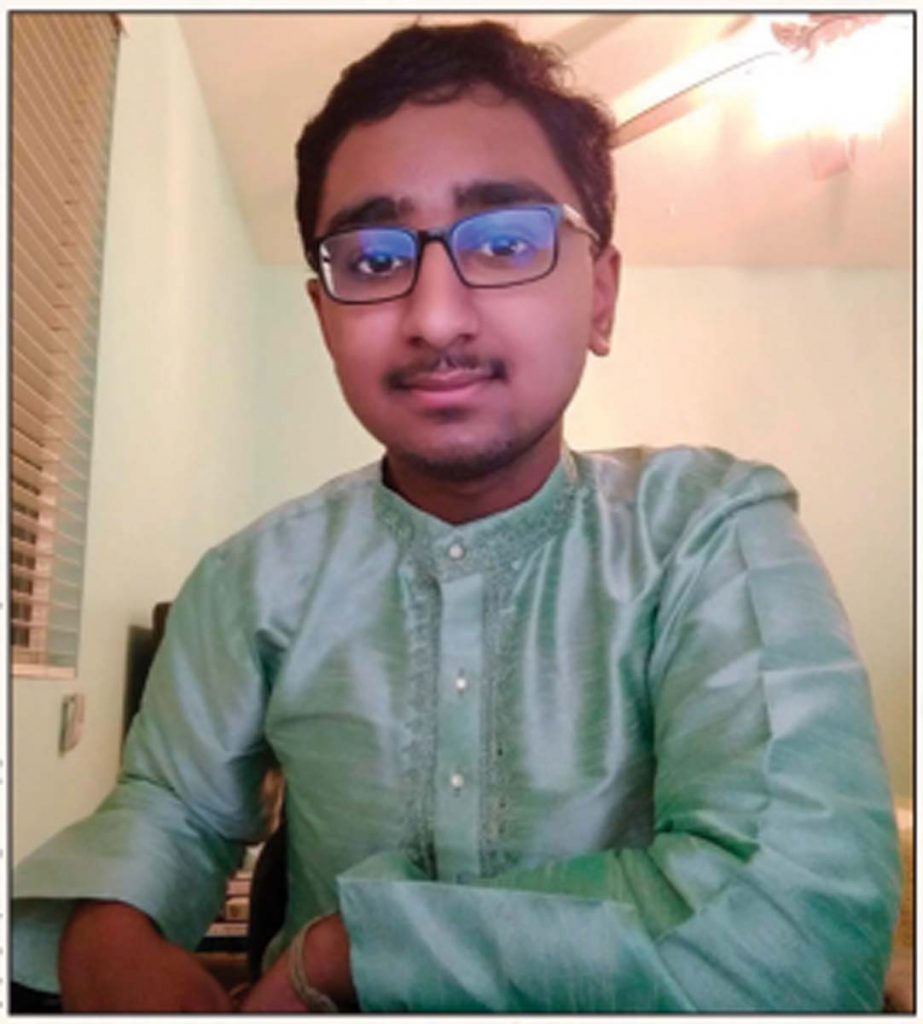
I’ve also met many parents who watch movies like “Miss Indian-American” and claim that they understand all second-generation Indians. There are dangers in using such absolutes. Hindu Americans cannot be considered a monolith. By understanding the commonalities and differences among us, we may be able to plan programs that truly ensure our culture remains in this nation far longer than we do.
One key factor in these differences is location. A Hindu living in my hometown of Shrewsbury, Massachusetts, for example, lives very differently than a Hindu in Florence, Kansas. Population plays a role in this. Some things are obvious, such that in areas like Pahrump, Nevada, it is harder to maintain Hindu culture. The five Hindu families that live there do the best they can with weekly gatherings in the lone Indian restaurant, the Pourhouse. However, it’s hard to run any religious or cultural classes, and they have to rely on online courses.
It might be assumed, following this, that a higher population is always better for a community. In truth, this only applies to an extent. In my conversations with one young man from Texas, he revealed to me that his apartment and town were full of Indians. I assumed that festivals such as Diwali or Holi would be celebrated with great zest by the whole community. In reality, the people simply split up into their various communities of Marathis, Punjabis, Tamilians and all the other various Indian groups rather than uniting around a common identity. Thus, it becomes clear that just as a lack of population is a threat to our culture, so too is overpopulation a threat to our unity. Both must be taken into account when planning any programs. For better or worse, our community is filled with a diversity of linguistic groups and different subcultures. This creates unique situations both between and within various ethnic groups.
For example, out of those who are fluent in their mother tongue, it is rare to find any who are fluent in more than one Indic language. This fact restricts the method of communication between friends of different communities to English, that being the only language everyone can understand.
The effect of this on individual linguistic groups varies, depending on the population and unity of the group. For example, the imposition of English hits harder in communities from India’s northeastern states, whose US populations, and thus opportunities to speak their mother tongue, are limited. The imposition of English on the youth of these populations can easily lead to a lack of cultural knowledge at best, and extinction of their languages in the United States at worst, a fate we must all work to prevent.
Aside from the populations of these linguistic groups, we can also find varying degrees of cultural pride within them. Tamil youth, for example, have taken great pride in their culture due to groups like SoCal Tamil Youth Leadership and Entrepreneurship, which allow them to volunteer with their Tamil peers. This pride then extends to the classroom as well, where I’ve seen many Tamilians speaking with each other in Tamil, an act that serves as an inspiration to us all.
Though the Gujarati community doesn’t speak in Gujarati as much in school, there is a significantly higher level of pride in their community as well, due to their abundance of community organizations such as the Gujarati Samaj and Swadhyay Parivar, which leads to Gujarati youth showing no hesitation to talk about their culture, even with non-Gujarati friends. This pays dividends in the long run.
Contrast this with youth from my home state of Maharashtra, and you’ll find a far different picture. I’ve met only two Marathis who were willing to talk with me in Marathi, and countless more who have yelled at me for doing so. Many Maharashtrians in America don’t know the language. The reason behind this is clear when we contrast the institutions created by Marathis to Gujarati and Tamilian institutions. While there are Marathi language schools, they only teach the language rather than why it is important to speak it, and only briefly touch on the idea of being a Hindu in a Western world, something first-generation Hindus have taken for granted. This lack of community easily leads to a lack of culture. This problem isn’t confined to the Marathi community, nor is it the case that only Gujaratis and Tamilians care about their culture. However, it is clear that the challenges we face strongly depend on how well our subculture teaches us about our traditions. Those who are born in a more unified population with large numbers, such as the Tamils, are far more likely to preserve their culture than those born in communities with fewer numbers, such as the Marathis.
There are, however, certain unifying factors amongst our diverse population. One of the better ones is a drive for academic success, one that has led to our people holding a high position in this society. Yet, at the same time, as with many religions, it is not uncommon to hear of youth skipping Holi functions to study, or refusing to join Hindu activities since they believe they won’t help them get into college.

For those in cities with a high level of education, such as Irvine, California, this competition is increased, and I have heard many Hindus tell me they skip their morning prayers, known as sandhyavandanam , because they have to study, or drop out of their Bal Vihar classes in middle school to focus on schoolwork. It becomes evident, then, that to retain these youth, we must ensure that we appeal to their self-interest.
Various groups, including non-Hindu ones, have tried to solve these issues for their people. Many Muslims have their kids take Arabic classes, and have them attempt to learn the Koran by heart, which is in stark contrast with those Hindus who rarely teach their kids more than a few verses from the Gita , or how to perform arati worship. Personally, I’ve met many in the Chinese community who have told their kids that they must ask for their food in Chinese if they wish to eat. Even amongst those groups who don’t put in as much effort teaching a language, the offering of that language—such as Spanish, Chinese or French—at schools inherently makes it easier for them to learn it, a luxury that speakers of Indic languages don’t have.
While local temples or community groups have tried to deal with these disadvantages by running events for youth and holding classes, these are local. They can’t help the many Hindus who live outside of the major Indian population centers. In addition, because there are few opportunities to participate in internships and gain volunteer hours in the Hindu community, many students and parents aren’t interested in such programs after the kids reach middle school and have other extracurricular classes and activities.
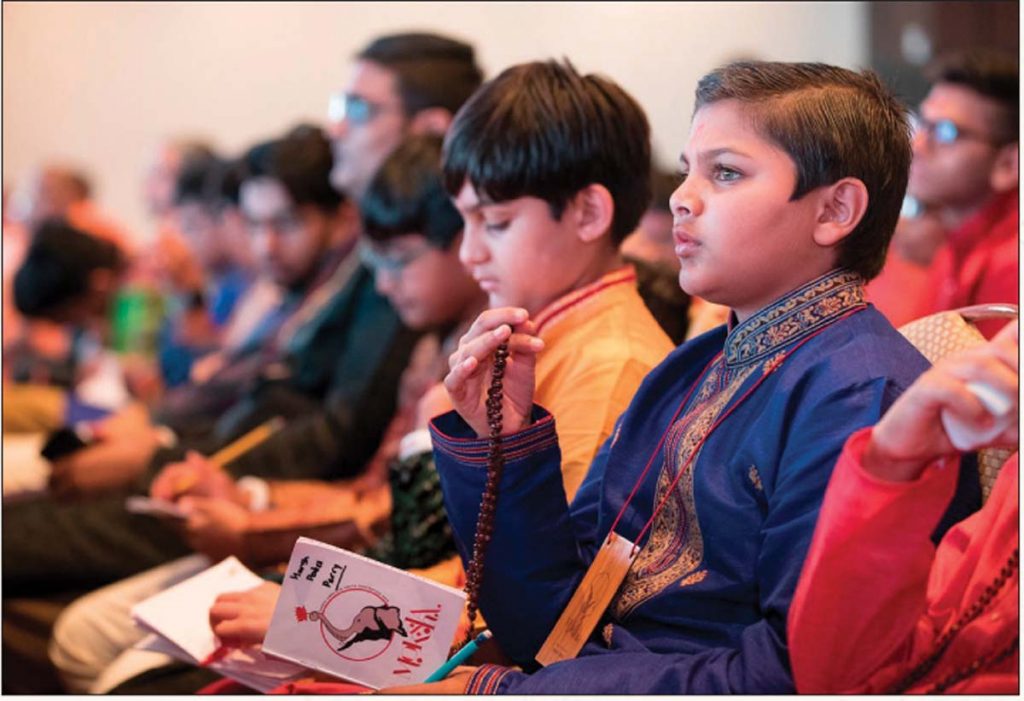
It should be noted, however, that the Hindu Swayamsevak Sangh did hold an internship program for students in the summer of 2020. If such programs continue, a rise in their membership is probable. Also, groups like Sanskrita Bharati have tried to incentivise students by accrediting their Sanskrit as a Foreign Language course, and even giving a certificate from the University of Pennsylvania at the end of the course. Similarly, courses in other Indian languages could be accredited so students not interested in Sanskrit could be engaged. As the Rig Veda says, there are many paths to one truth. If students are interested in a certain area of Hinduism, we must make sure study in that area is open to them.
It’s clear, then, that Hindu students are diverse and face a wide variety of challenges. Any program that seeks to educate them must find ways to cross local barriers and help students feel pride both in their regional tradition as well as wider Hindu culture. In addition, such programs must also offer benefits that will directly help students succeed in their career, and try to cater to the interests of as many students as possible. If such steps are implemented, it is likely that the program will succeed.
How Meditation Made Me a Better Dancer
By Santhanaa Hariharaputran, 16
WHAT IS MEDITATION? IS IT THE ART OF engaging in contemplation or reflection for the purpose of attaining an elevated level of spiritual awareness? Or is it something that goes beyond the mind and transmutes into an art form of beauty and grace?
As an Indian-born child raised in America, my interactions with the distinctive skill of meditation were quite limited. In fact, my perception of meditation before the age of seven consisted of grown ups posing in awkward positions and closing their eyes for prolonged periods of time. Our generation believed meditation and yoga were activities done by adults whose mobile abilities were very limited or those who were so tired from life’s abundantly tiring activities that they were completely fine with sleeping in a rather uncomfortable position.
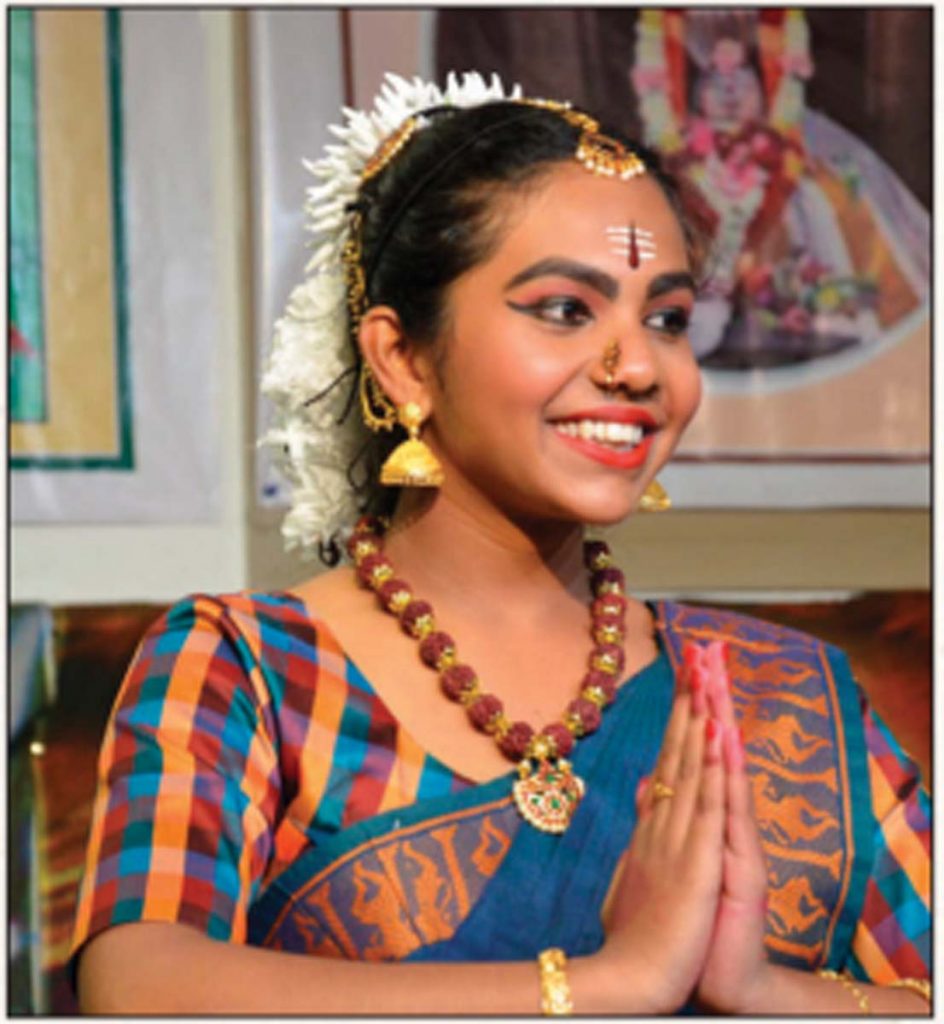
Every summer I went back to India where I had a close-knit group of friends, most from my Bharatanatyam dance class. If it were closely examined, my little group of dance buddies could easily fit into the modern-day friend-group stereotype. We had a class clown, we had a “Mom” of the group, there was the one who was always hungry, and then there was me, the “go-with-the-flow” girl. The four of us pretty much made up 95% of the entertainment in our class. When we weren’t dancing, we were joking around and participating in witty debates and discussions with other classmates. Since most of the entertainment in our class came from the four of us, it only seemed fit that our class clown (let’s just call him Krishna, since I don’t think he’d like his real name here) was creating all the drama.
To the outside world, Krishna and our dance teachers (whom we called our gurus) never got along with each other, due to Krishna’s playful misbehavior that only seemed to happen in class. I remember the first time our gurus openly expressed annoyance at his conduct. It was a normal dance session and our gurus were teaching the older students a class, which none of the rest of us could identify as a meditation session. As if on cue, Krishna walked in with his usual carefree demeanor and started mocking how everyone looked like they were sleeping, in a class that was supposed to be filled with spirit and energy. Unlike their usual routine of laughing off whatever he said, however, our gurus were mildly annoyed and told Krishna to sit through the lesson with them. Class, as we knew it, ended for the rest of our group and we waited for Krishna to be released from his “punishment.” We never talked about what happened during the session, but Krishna seemed so interested that he joined the following day also. Naturally, the rest of us wanted to witness this fascinating event, so we joined the session out of curiosity.

To us, the hour-long session felt like an eternity. We could not keep quiet for longer than two minutes at a time, though that wasn’t the case with Krishna. To our astonishment, he followed every single instruction from our gurus with utmost silence and respect, bewildering even the older kids. After the session, our initial shock at Krishna’s sudden open display of respect turned into a mild worry. We decided to confront him about his new-found courtesy towards our gurus and all that they do.
He replied in a manner so simple it was hard to catch the seriousness in his voice, “Our gurus taught me about the importance of meditation.” That was it. He did not add to this simple sentence and left us worrying about whether he got hit in the head and forgot about his usually extremely playful self. His response, however direct it was, still piqued my curiosity. I asked him more about it the next day, but did not get a response any more informative than his previous one. He seemed to imply I should ask our gurus myself. So I did.
Our gurus were pleased to find such young students asking so many questions about an art form they would usually reserve for the more experienced students and told us all about the importance of meditation and yoga in dance. We learned about each of the chakras we utilize when dancing and how we could achieve better control over our movements through meditation. We learned about the existence of a superior power, and how surrendering to this higher power would help us become one with the forces spiritually, and with Mother Earth physically. Unfortunately, none of us really knew what was meant by “superior power.” We tried clarifying with our gurus, but they could only offer that we would know it when we felt it.
Of course, this did not serve as an adequate answer to our overly active minds, so we started asking the older students if they had gotten a hold of this “superior power” to help them with their dance. According to them, believing in the existence of another force with which we could connect to help guide us through our dance without messing up brought a sense of reassurance and confidence that helped them perform complicated dance pieces. At the age of seven, the four of us felt as though something that did not have a direct correlation with our physical dances would not really help us in any way. Thus, we kept nagging our gurus about the question until they gave their final answer in terms that we could understand, or at least think about. They said, “Many say that practice makes perfect, but what good is practice when the mind, soul and body are not connected? What good is that practice when there is no focus or control?”
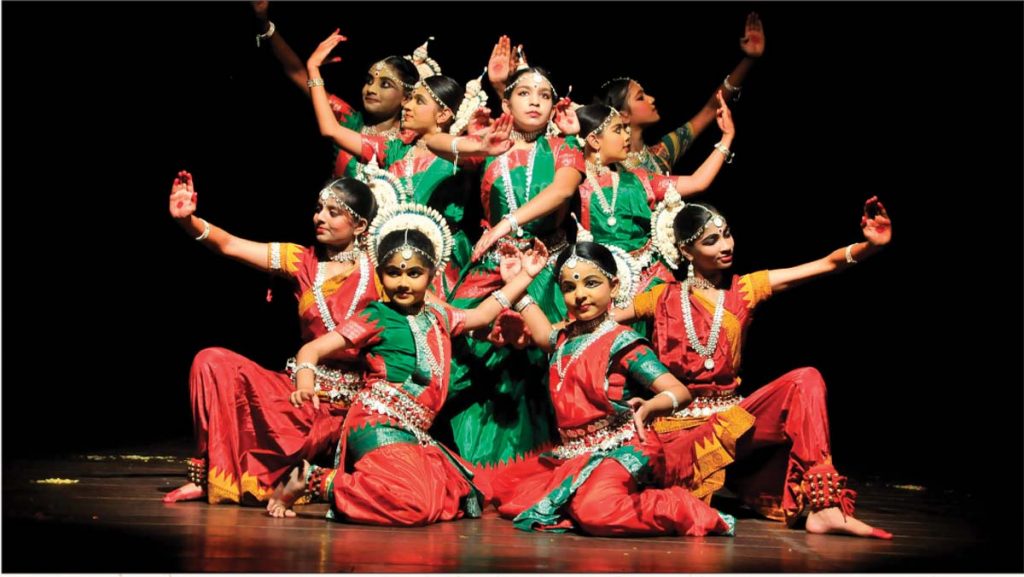
With that, we practiced meditating every day before and after our dance sessions, and each following dance routine reflected the calm tranquility and utter control of our meditation. The first day was rough. Our little seven-year-old bodies were filled with energy no matter how long we danced, so the amount of time in which we could sit still was less than five minutes. By the end of the month, however, we were all keeping pace with the older kids. We could sit through hour-long sessions without having any interruptions by us, and our dancing improved greatly. I know “greatly” could be taken as a relative term, but by the end of the first month, I could see how each of my symbolic hand gestures, mudras , were more defined and how the speed and precision of each step were enhanced. We were able to control our core and minimize flailing around. For a group of seven-year-olds, the change in how we delivered our expressions was truly mesmerizing to the audience.
I still practice meditating whenever I get the time to do so, and I still practice Bharatanatyam as well. I participate in weekly dance classes and try my best to meditate for at least ten minutes before and after class, which helps me get into the mood of dancing. It is similar to a cleansing ritual, only I’m washing away everything that happened during the past week from my mind. What I meditate away during this ritual depends purely on the type of dance piece we are practicing each lesson. If the dance is supposed to be happy, then I wash away all the stressful or otherwise bad things that may have occurred during the week. If the dance piece is supposed to be sad, then I meditate focusing on anything sad that has happened. Of course, I am not doing this to hurt myself in any way, but only to bring out the expression needed to convey the story of the dance. Even dancers with the best facial expressions and the cleanest moves might not have the stamina needed to complete difficult pieces. For them, most dance teachers recommend meditation.
A key component of meditation is controlling your breathing. When we do more meditation and learn to control our breathing, we use less oxygen when dancing, thereby increasing our stamina. Meditation not only helps with stamina and control, but it also helps with stress. Now, I would be lying if I were to say that meditating relieved all my stress and that I am living a stress-free life, because really, only music does that for me. However, I am able to minimize my anxiety through meditation because it helps me focus. So, when I focus on a task that would otherwise make me feel overwhelmed, I am able to get it done quicker by meditating a couple of minutes beforehand and improving my focus. Of course, sometimes a few minutes is not enough, due to the amount of pressure an average teenager experiences. But I usually feel a difference a couple of minutes into whatever activity that I am working on—usually a sense of productivity and sometimes an adrenaline rush to motivate my system to work on and finish the task at hand. So yes, meditation not only helps with controlling my movements and with readying myself for the precise execution of my dance, but it also helps me destress and gain a better perspective on life. I have been meditating for the past eight years, and am proud to say that I have experienced the extensive benefits meditation brings of peacefulness, control and stamina in both my dance and my life.
Born in Kanyakumari, Tamil Nadu, and now residing in Orange County, California, Santhanaa Hariharaputran is a Bharatanatyam dancer and a devout Hindu. In her spare time, she aspires to be a polylinguist and violinist and to pursue her passion for medicine. Contact her at: santhanaamhari@gmail.com
